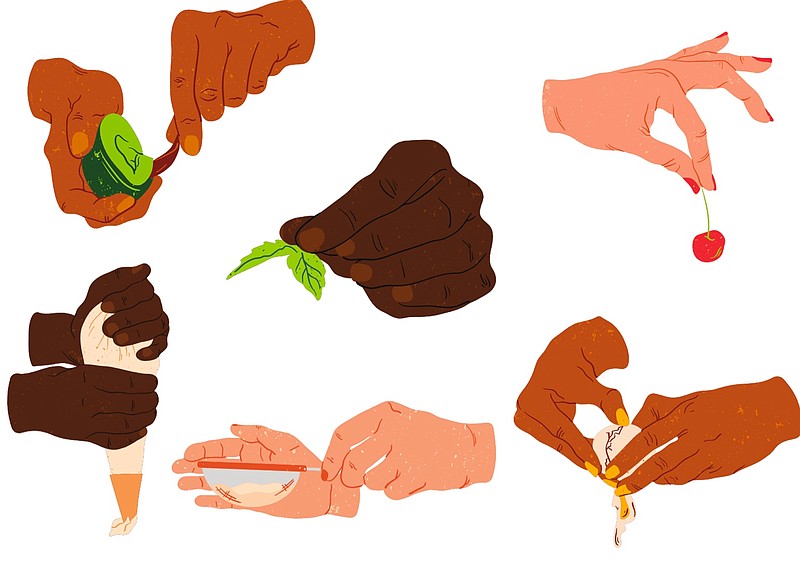"I planted some [Tahitian squash] this year for fun. Got several big ones. Supposed to be sweet. Can't find a decent recipe for soup or cooking. Any ideas?" — Jeff Everett
I've eaten and written about a lot of winter squash over the years, but Tahitian is not one of them. So I turned to those more knowledgeable: heirloom seed catalogs, specialty produce sellers and a few trusted cooking websites.
Here's what I learned:
◼️ Also known as melon squash, Tahitian squash are giants of the winter squash world. The best way to describe them is they look like a cross between crookneck and butternut squash, but on steroids.
◼️ They can weigh up to 30 pounds, but they average about 12 pounds.
◼️ You needn't use the entire squash at once. Simply cut off what's needed for a recipe and let the remaining squash sit out on the counter in the open air and the squash will "heal" itself. Do not refrigerate them.
◼️ The bulbous end holds the seed cavity and has stringy flesh similar to spaghetti squash.
◼️ The flesh of the nonbulbous end is smoother, more like butternut squash.
◼️ The flesh is sweet and gets sweeter with cooking — roasted, steamed, baked or grilled — but it can also be grated and eaten raw.
◼️ It can be used in any recipe that calls for winter squash, keeping in mind the differing textures. Below you'll find one of my favorite winter squash soup recipes.
If you have a recipe for using Tahitian squash, please share.
Roasted Winter Squash Soup
- 1 Tahitian squash or any large winter squash
- Olive oil
- Salt and ground black pepper
- 1 head garlic
- 1 yellow onion, finely diced
- 1 to 2 teaspoons cumin, or to taste
- 1 to 2 teaspoons coriander, or to taste
- 1 to 2 teaspoons smoked paprika, or to taste
- 1 to 2 teaspoons ground medium-hot chile pepper such as ancho or aleppo, or to taste
- 8 cups low-sodium vegetable stock
- ½ cup half-and-half, optional
- Fresh snipped chives, for garnish
Heat oven to 375 degrees. Line a baking sheet with foil.
Cut squash in half lengthwise. Remove and reserve seeds for roasting if desired (see note). Arrange squash cut side up on the prepared baking sheet. Coat cut side of squash with olive oil and season with salt and pepper.
Cut the top third off the pointed end of the head of garlic. Place garlic on the baking sheet with the squash. Drizzle with olive oil and season with salt and pepper.
Roast the squash and garlic for 20 minutes; turn squash to cut side down and roast 20 minutes more or until squash and garlic are tender.
Heat enough olive oil to coat a Dutch oven or soup pot over medium heat. Add onion and saute until onion is tender.
Scoop flesh from squash. Discard skin. Add flesh to pot with onion. Remove the garlic from the papery skin and add it to the pot; cook, stirring occasionally, for 5 minutes. Stir in the spices and vegetable broth. Bring to a boil, then reduce heat and simmer 20 minutes. Season to taste with additional salt, pepper, cumin, coriander, paprika and/or chile pepper.
Remove from heat, and using an immersion blender (or in a traditional blender) puree soup to desired consistency. Stir in half-and-half, if using. Return soup to heat and cook until just heated through, being careful not to let the soup boil. Serve garnished with snipped chives and roasted squash seeds, if desired.
Makes 10 to 12 servings.
Note: To roast the seeds for garnishing or snacking: Heat oven to 350 degrees. Thoroughly rinse the seeds, making sure to remove any stringy squash guts and flesh. Place the cleaned seeds in a large pot and add 1 tablespoon kosher salt per cup of seeds and enough cold water to cover. Bring to a boil; reduce heat and simmer 10 minutes. Drain thoroughly. Spread in a single layer on a rimmed baking sheet lined with foil or parchment. Let dry for a few minutes and then drizzle with a little olive oil. Sprinkle with desired seasoning — I like ancho chile powder and cumin — stir to coat. Roast 10 to 20 minutes or until browned and fragrant. Immediately transfer seeds to a separate baking sheet and cool completely. Use right away or store in an airtight container for up to a week.
Email recipe contributions, requests and culinary questions to: [email protected]

